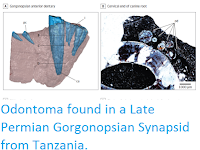The Dalongkou Section of the Guodikeng Formation in Jimsar County in northern Xinjiang Province, China, is one of the few terrestrial sections that preserve the transition from the Permian to the Triassic periods, one of the most important biological turnovers in the fossil record. This section has produced a variety of Vertebrate fossils, adding to our knowledge of a variety Vertebrate groups known only from this time interval.
In a paper published in the journal Vertebrata PalAsiatica on 28 November 2016, Liu Jun of the Key Laboratory of Vertebrate Evolution and Human Origins at the Institute of Vertebrate Paleontology and Paleoanthropology of the Chinese Academy of Sciences and the University of Chinese Academy of Sciences and Fernando Abdala of the Evolutionary Studies Institute at the University of the Witwatersrand describe two new Late Permian Vertebrate specimens from the Dalongkou Section of the Guodikeng Formation.
The first new specimen is identified as a Eutherocephalian, a group of Theraspids (the wider group that includes living Mammals and their ancestors) known from the Middle Permian to the Middle Triassic, and described as a new species, Dalongkoua fuae, where 'Dalongkoua' refers to the location where the specimen was found (the Dalongkou Section) and 'fuae' honours Fu Hua-Lin, who prepared the specimen. The specimen comprises an incomplete left premaxilla with three teeth, an incomplete right premaxillae with four teeth, the snout and part of the orbital region with the maxilla on both sides featuring functional and replacement canines, some isolated vertebrae, a left humerus, two phalanges and some bone fragments.
The second specimen is identified as a Chroniosuchian (a group that may either be either Stem Tetrapods - a group that split off from other Tetrapods before the split between Lisamphibians and Amniotes - or Reptiliomorphs - Amniotes that split off from other groups before they diverged), but not described to species level due to the fragmentary nature of the material. This specimen comprises five vertebrae, a rib, some gastral scales, a partial ilium, a left femur, and a partial fibula.
See also...
Dalongkoua fuae: Skull, including premaxilla in left lateral (A), right lateral (B) and ventral (C) views; right premaxilla in dorsal view (D); the second preserved right incisor in lingual view (E) Abbreviations: F. frontal; J. jugal; M. maxilla; N. nasal; Pf. prefrontal; Pm. premaxilla; Po. postorbital; r.c. replacing canine; t.f. temporal fenestra; V. vomer. Scale bar equals 1 cm. Lui & Abdala (2016).
The second specimen is identified as a Chroniosuchian (a group that may either be either Stem Tetrapods - a group that split off from other Tetrapods before the split between Lisamphibians and Amniotes - or Reptiliomorphs - Amniotes that split off from other groups before they diverged), but not described to species level due to the fragmentary nature of the material. This specimen comprises five vertebrae, a rib, some gastral scales, a partial ilium, a left femur, and a partial fibula.
Chroniosuchian specimen sterior (C), dorsal (D) and ventral (E) views; one caudal vertebra in anterior (F), left lateral (G), posterior (H), and ventral (I) views; J. gastral scales; caudal intercentrum in anterior (K), left lateral (L), and ventral (M) views Abbreviations: dp. diapophysis; ha. haemal atch; ic. intercentrum; nc. neural canal; ns. neural spine; pc. pleurocentrum; pnc. paraneural canal; poz. postzygapophysis; pp. parapophysis; prz. prezygapophysis; tp. transverse process. Scale bar equals 1 cm. Lui & Abdala (2016).
See also...
Follow Sciency Thoughts on Facebook.








